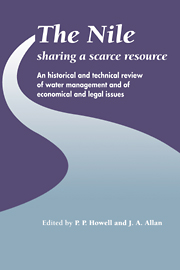 The Nile: Sharing a Scarce Resource
The Nile: Sharing a Scarce Resource Book contents
- Frontmatter
- Contents
- Preface
- List of Contributors
- Orthography
- Units and Conversion Factors
- Introduction
- I Environmental history of the Nile and its management
- II Nile management and factors affecting future management
- III Future utilisation of Nile waters
- 8 Future irrigation planning in Egypt
- 9 Future water development planning in the Sudan
- 10 Irrigation and hydro-power potential. Water needs in Uganda, an overview
- 11 The integrated development of Nile waters
- 12 The control of the swamps of the southern Sudan: Drainage schemes, local effects and environmental constraints on remedial development
- 13 Water balance of the Bahr el Ghazal swamps
- IV Economic, international and legal issues
- Index
11 - The integrated development of Nile waters
Published online by Cambridge University Press: 05 February 2012
- Frontmatter
- Contents
- Preface
- List of Contributors
- Orthography
- Units and Conversion Factors
- Introduction
- I Environmental history of the Nile and its management
- II Nile management and factors affecting future management
- III Future utilisation of Nile waters
- 8 Future irrigation planning in Egypt
- 9 Future water development planning in the Sudan
- 10 Irrigation and hydro-power potential. Water needs in Uganda, an overview
- 11 The integrated development of Nile waters
- 12 The control of the swamps of the southern Sudan: Drainage schemes, local effects and environmental constraints on remedial development
- 13 Water balance of the Bahr el Ghazal swamps
- IV Economic, international and legal issues
- Index
Summary
Introduction
Integrated river basin development should be perceived as as set of anthropogenic activities which takes place in an interlinked and complex ecosystem. The Nile Basin is one such system which represents a very large and highly valued hydrological unit.
This chapter discusses the Nile Basin as an ecological entity and it is assumed that all nine co-basin states could equitably share, utilize and manage natural resources for the mutual benefit and welfare of the basin's population. To this end, the chapter outlines strategic and historically controversial issues that must be addressed, and provides a framework for meaningful regional cooperation and coordination. It discusses issues of water allocation, priority research areas, and gives specific recommendations to support and achieve sustainable use of water.
According to O'Riordan and More (1971, p.194) a water resource system is an integrated complex of interlinked hydrological and socio-economic variables operating together within a well-defined area, commonly a drainagebasin unit. Such systems are composed of interlinked sub-systems, which are simpler on account of the smaller number and greater simplicity of components, their more restricted areal coverage, and their more restricted aims. The whole drainage basin is a sound basis for the integrated development of resources. However, the water needs of modern states often demand the creation of a comprehensive super-system, in which, for example, a socio-economic policy is imposed on a variety of drainage-basin units (each perhaps having very different hydrological characteristics), or in which one very large and uniform hydrological unit is developed under a number of differing socio-economic bases (usually national).
- Type
- Chapter
- Information
- The Nile: Sharing a Scarce ResourceA Historical and Technical Review of Water Management and of Economical and Legal Issues, pp. 227 - 242Publisher: Cambridge University PressPrint publication year: 1994
- 1
- Cited by


